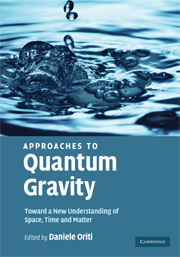Book contents
- Frontmatter
- Contents
- List of contributors
- Preface
- Part I Fundamental ideas and general formalisms
- 1 Unfinished revolution
- 2 The fundamental nature of space and time
- 3 Does locality fail at intermediate length scales?
- 4 Prolegomena to any future Quantum Gravity
- 5 Spacetime symmetries in histories canonical gravity
- 6 Categorical geometry and the mathematical foundations of Quantum Gravity
- 7 Emergent relativity
- 8 Asymptotic safety
- 9 New directions in background independent Quantum Gravity
- Questions and answers
- Part II String/M-theory
- Part III Loop quantum gravity and spin foam models
- Part IV Discrete Quantum Gravity
- Part V Effective models and Quantum Gravity phenomenology
- Index
7 - Emergent relativity
from Part I - Fundamental ideas and general formalisms
Published online by Cambridge University Press: 26 October 2009
- Frontmatter
- Contents
- List of contributors
- Preface
- Part I Fundamental ideas and general formalisms
- 1 Unfinished revolution
- 2 The fundamental nature of space and time
- 3 Does locality fail at intermediate length scales?
- 4 Prolegomena to any future Quantum Gravity
- 5 Spacetime symmetries in histories canonical gravity
- 6 Categorical geometry and the mathematical foundations of Quantum Gravity
- 7 Emergent relativity
- 8 Asymptotic safety
- 9 New directions in background independent Quantum Gravity
- Questions and answers
- Part II String/M-theory
- Part III Loop quantum gravity and spin foam models
- Part IV Discrete Quantum Gravity
- Part V Effective models and Quantum Gravity phenomenology
- Index
Summary
Introduction
This chapter wants to be two things. On the one hand it wants to review a number of approaches to the problem of Quantum Gravity that are new and have not been widely discussed so far. On the other hand it wants to offer a new look at the problem of Quantum Gravity. The different approaches can be organized according to how they answer the following questions: Is the concept of a spacetime fundamental? Is a background time used? Are Einstein's equations assumed or derived? (See figure 7.1.)
In string theory, loop quantum gravity, and most other approaches reviewed in this book spacetime plays a fundamental role. In string theory a given spacetime is used to formulate the theory, in loop quantum gravity one tries to make sense of quantum superpositions of spacetimes. It is these spacetimes in the fundamental formulation of the theory that are directly related to the spacetime we see around us. In this broad sense these approaches treat spacetime as something fundamental. Here we want to focus our attention on approaches that take a different view. In these approaches spacetime emerges from a more fundamental theory.
The next questions concern the role of time. The models that we will be looking at will all have some sort of given time variable. They differ though in the way they treat this time variable. One attitude is to use this time variable in the emergent theory.
- Type
- Chapter
- Information
- Approaches to Quantum GravityToward a New Understanding of Space, Time and Matter, pp. 99 - 110Publisher: Cambridge University PressPrint publication year: 2009
- 2
- Cited by

